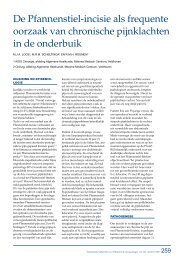Surgical management of chronic inguinal pain syndromes - Liespijn
Surgical management of chronic inguinal pain syndromes - Liespijn
Surgical management of chronic inguinal pain syndromes - Liespijn
You also want an ePaper? Increase the reach of your titles
YUMPU automatically turns print PDFs into web optimized ePapers that Google loves.
INTRODUCTIONWorldwide, many patients are affected by <strong>chronic</strong> <strong>pain</strong> after ‘routine’ <strong>inguinal</strong> herniarepair 1 . Determining the specifics <strong>of</strong> this <strong>chronic</strong> <strong>pain</strong> may be challenging. Recently, aclassification identifying three, separate, <strong>pain</strong> <strong>syndromes</strong> was proposed by our group <strong>of</strong>investigators 2 . First, <strong>pain</strong> <strong>of</strong> neuropathic origin (also termed neuralgia) is demonstratedin about half <strong>of</strong> the patients. They present with a sharp <strong>pain</strong> that irradiates to the scrotum,upper leg, or back. Symptoms usually appear immediately after the hernia repair,but a delayed presentation may also occur. Physical examination reveals neurophysiologicabnormalities, including hyper-/ hypoesthesia or allodynia with a trigger pointusually situated in proximity to the incision. Diagnostic nerve blocks with a short-actinganaesthetic agent confirm the diagnosis 2 . At operative exploration, <strong>inguinal</strong> nerves(iliohypogastric, ilio<strong>inguinal</strong> or genital branch <strong>of</strong> the genit<strong>of</strong>emoral nerve) may be found‘entrapped’ by suture material or encased in fibrosis. A traumatic neuroma may be identifiedon histologic examination 2 .Second, about 25% <strong>of</strong> the population may harbor non-neuropathic <strong>pain</strong> <strong>syndromes</strong>including pubic periostitis, mechanical irritation due to wadded mesh (‘meshoma’) 3 ,recurrent <strong>inguinal</strong> hernias, or musculoskeletal overcompensation. Suture material penetratingperiostal layers <strong>of</strong> the pubic tubercle may result in a <strong>chronic</strong> inflammatory state 3 .Third, the remaining quarter <strong>of</strong> the affected patients presents with diffuse <strong>pain</strong> situatedin proximity <strong>of</strong> the spermatic cord without signs <strong>of</strong> nerve entrapment (‘funiculodynia’) 2 .This latter syndrome may be related to venous congestion or mesh-related inflammation<strong>of</strong> the spermatic cord.A combination <strong>of</strong> neuropathic and non-neuropathic <strong>pain</strong> <strong>syndromes</strong> is not uncommon.A number <strong>of</strong> conservative treatment modalities has been proposed for postoperative<strong>inguinal</strong> neuralgia, including nerve blocks 4 , medication, Transcutaneous Electric NeuroStimulation (TENS), or capsaicin crème 5 . Data on the efficacy <strong>of</strong> these modalities,however, are scarce. Patients with refractory <strong>pain</strong> may undergo operative exploration <strong>of</strong>the groin. Long-term <strong>pain</strong> relief in small studies is found between 60 to 100% afterneurectomy 3,6-12 . The aim <strong>of</strong> the present study was to assess whether a selective operativeneurectomy provides satisfactory results for postherniorrhaphy <strong>inguinal</strong> neuralgia.ANATOMY AND PATHOPHYSIOLOGYKnowledge on <strong>inguinal</strong> neuroanatomy is crucial. There are four <strong>inguinal</strong> nerves, theiliohypogastric, ilio<strong>inguinal</strong>, genit<strong>of</strong>emoral, and lateral femoral cutaneous nerve. As thelatter is only at risk during laparoscopic hernia repair, it will not further be discussed. Thefollowing neuroanatomy will apply in most patients, but anatomic variations areexceedingly common 3,13 .The iliohypogastic nerve arises from T12/ L1 and runs ventrally from the quadratus lumborummuscle and gradually pierces the various layers <strong>of</strong> the abdominal wall. It may beinjured accidentally during dissection or may become encased in fibrotic tissue orsuture material after mesh fixation. The ilio<strong>inguinal</strong> nerve originates from the samevertebral level and travels a similar course a few centimetres caudal from the Iliohypogastricnerve. It is damaged easily during opening <strong>of</strong> the <strong>inguinal</strong> canal or dissection <strong>of</strong>the spermatic cord, or it may be entrapped by closing <strong>of</strong> the external oblique aponeurosisor encased by fibrotic tissue after mesh implantation later on. The genit<strong>of</strong>emoralnerve originates from L1/ L2 and pierces the iliopsoas muscle where it lies on its ventralsurface. The genit<strong>of</strong>emoral nerve demonstrates a clear division into a genital andfemoral branch some several centimetres proximal to the <strong>inguinal</strong> ligament. The genitalbranch runs posterior to the spermatic cord and is at risk during spermatic corddissection, or may be caught by constriction at the internal ring or by perineural fibrosis.Moreover, the main trunk with its branches can also be harmed by a laparoscopicallyplaced preperitoneal mesh. Its <strong>inguinal</strong> segment can be injured if fixating devicespenetrate through the transversal fascia and entrap the nerve.PATIENT AND METHODSA database search was performed identifying all consecutive patients treated by thesenior authors (M.S. and R.R.) who underwent a neurectomy for postherniorrhaphy<strong>inguinal</strong> neuralgia in the Máxima Medical Center (MMC, Veldhoven, The Netherlands)between January 2003 and June 2008. Our hospital is a 865-bed hospital in theSoutheastern part accommodating some 350.000 individuals. The yearly number <strong>of</strong>primary <strong>inguinal</strong> hernia repairs is about 500. Most patients with postherniorrhaphy<strong>inguinal</strong> neuralgia were treated according to a previously published algorithm 14 . Inclusioncriteria were unilateral <strong>inguinal</strong> hernia repair and >3 months <strong>of</strong> <strong>pain</strong> associatedwith the operative procedure. Patients treated for non-neuropathic <strong>pain</strong> <strong>syndromes</strong>exclusively (pubic periostitis, meshoma) were excluded. All medical and surgical recordswere obtained to determine the duration <strong>of</strong> <strong>pain</strong> symptoms, type <strong>of</strong> <strong>inguinal</strong> herniarepair and previous <strong>pain</strong> treatments (e.g. nerve blocks, neurectomies, <strong>pain</strong> medication).Findings on physical examination including neurophysiologic abnormalities and triggerpoints were assessed. Special attention was paid to the palliative effect <strong>of</strong> nerve blocksand imaging modalities (CT/ MRI). Finally, diagnosis as well as number <strong>of</strong> operativeinterventions, postoperative complications, and histopathologic findings were tabulated.Operative techniqueAll patients were <strong>of</strong>fered operation using spinal or general anaesthesia in a day-caresetting. They received 5.000 IU <strong>of</strong> low molecular heparin (Fragmin®, Pfizer bv, Capelle82 Chapter 6Tailored neurectomy for treatment <strong>of</strong> postherniorrhaphy <strong>inguinal</strong> neuralgia 83





